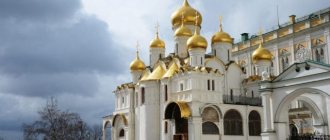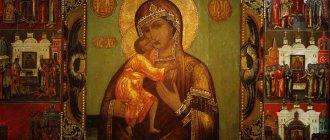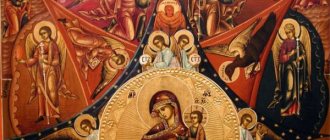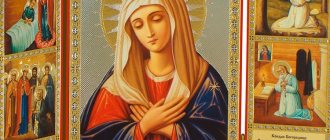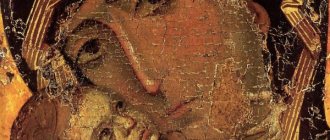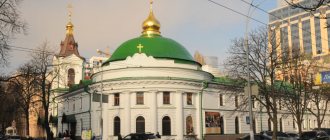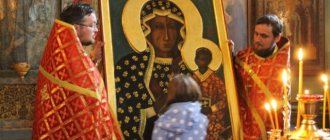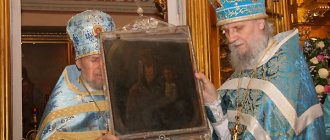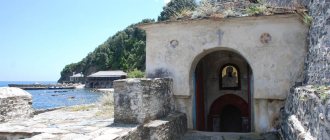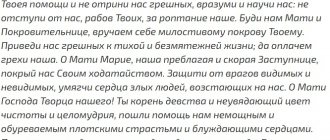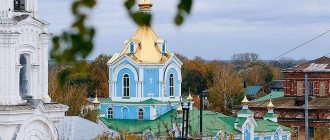According to legend, the Jerusalem Icon of the Mother of God was painted by one of Jesus’ apostles, Luke, just 15 years after the Ascension of the Savior, that is, in 48. She became the first of seventy lifetime images of the Mother of God, painted by the Apostle Luke.
If we describe the history of the Jerusalem icon briefly, we will note only the main milestones. The icon was initially given to the Jerusalem Christian community; in 463 it was transferred to the Constantinople Church of the Mother of God, and when the city was threatened with an attack by the Scythians, a popular prayer service in front of the Jerusalem icon protected the city from it.
In 988, when Prince Vladimir was baptized in Korsun (Kherson), he received this icon as a gift, and then gave it to the people of Novgorod when the residents of the city accepted the Christian faith. In 1571, the icon from the Novgorod St. Sophia Cathedral, by order of Tsar Ivan the Terrible, was transferred to the Kremlin Assumption Cathedral. In 1812, the miraculous Jerusalem Icon of the Mother of God was captured by the French. It is believed that she was taken to France, however, according to the French side, she is not in the inventory of Notre Dame Cathedral. Currently, in the Assumption Cathedral there is an ancient copy of the Jerusalem icon “Theotokos”.
History of the appearance of the image
It is known that this shrine was created during the life of the Queen of Heaven, the Immaculate Virgin Mary. The authorship of the holy image belongs to the Apostle Luke, who personally knew the Mother of God and lived with her in those ancient times. The icon was created in Gethsemane, near Jerusalem. The estimated year of creation of the shrine is 48, after the Nativity of Christ. The artist painted it 15 years after the most wonderful Ascension of the Lord.
Where exactly the shrine was located for three whole centuries is not known for certain. Perhaps the image was hidden in the Roman province of Antioch in some Christian community during the period of persecution of the first Christians. By a miracle and the prayers of believers, the shrine was preserved. When the danger had passed, the image was placed in a place where people could pray to the Mother of God.
There is a version that supposedly after the end of the persecution of Christians, the icon could have been installed in one of the temples in Jerusalem. Perhaps the shrine stood in the Temple of the Ascension of Christ, built in the year 335 in the same city. Christians believe that it was from the Jerusalem image that grace came to Mary of Egypt, which helped save her from the Fall.
A more precise location of the icon can be traced back to the 4th century. In 463, the shrine ended up in Constantinople - in the Church of Our Lady of Pigius. There is an ancient legend that this icon helped the city escape from the Scythians. During the attack of nomads on Constantinople (during the reign of Emperor Heraclius (575-641)), Christians prayed to the Jerusalem shrine. The Immaculate Virgin helped them win, and the city managed to withstand the onslaught of the enemy. Then the holy image was transferred to the Blachernae Church of Byzantium. The icon stood in this temple for three centuries.
In 988, the Jerusalem shrine was given as a gift to Vladimir, who baptized Rus'. This gift was given by his wife Anna, a Byzantine princess, who brought this image from Constantinople. There is an assumption that it was the Jerusalem shrine that helped the pagan prince accept Christianity.
The Grand Duke first placed the icon in Kyiv, and then transported it to Novgorod and presented it to the Novgorodians who were baptized. For 400 years, the location of the icon was the St. Sophia Cathedral of Veliky Novgorod. Only in 1571 did the Russian Tsar Ivan the Terrible order the greatest shrine to be moved to the Assumption Cathedral in the capital.
The most holy image of Jerusalem, according to historians, remained in the Kremlin until 1812. During the invasion of Napoleon’s army, the shrine mysteriously disappeared. There is an assumption that the most holy image was stolen and taken to distant France, where it is kept to this day among the exhibits of Notre Dame Cathedral. True, the French themselves deny this fact.
No one knows where the original is actually located. But there are many copies or copies of the Jerusalem image kept in various churches.
Compositional features
The icon “Tree of the Blessed Virgin Mary” appeared relatively recently - at the beginning of the 21st century. This is a very young age for an icon, but today it can be found everywhere - in churches, church shops and home altars. The main feature of the icon is its collectivity, since it depicts 16 faces of the Virgin Mary; in general, it somewhat resembles a family tree, but each individual image describes the Virgin Mary as the Queen of Heaven.
Read about church life:
- About the Sacrament of Confirmation in the Church
- Why and why do Orthodox Christians have many churches?
- How to behave correctly in church for children
The icon is characterized by its collectivity - in total there are 16 different images of the Virgin Mary, which are arranged in the form of branches of one tree. Each Mother of God holds the Child Christ in her arms.
The composition consists of:
- 7 images on the right;
- 7 images on the left;
- "Vladimirskaya" from below;
- Birth of Christ from above;
- outlines of heavenly Jerusalem under the image of “Vladimirskaya”.
The central link is the cave in Bethlehem, in which Christ was born, the Mother of God and the Baby Jesus, located in a manger. This image is larger than the others. Since the Child Christ is the only One who should be worshiped, He cannot but be on the board. It was His birth that made the Virgin Mary the Mother of God
That is why the picture of His birth is presented in the center - this is the most important event for humanity
Under the painting of the birth is the image of the “Sweet Kiss” as a symbol of the special love and connection between the Mother of God and Jesus Christ. And on the sides of the birth picture there are seven famous icons of the Mother of God, which are considered miraculous by the Orthodox world.
The tree is decorated with large roses and leaves as a symbol of life, which comes from the Lord God.
Compound
Each of the 14 images is made in a classic manner: the shape of an elongated oval, which is enclosed in a kind of medallion. The main difference between these images and canonical icon painting is that the Virgin Mary is depicted smiling in each image.
For reference! The only icon in which the Virgin Mary smiles is the “Bethlehem” one, but the author did not depict it on the “Tree”.
There is no analogue of this icon in Orthodox icon painting. Images of a tree, in principle, are quite often found in various images, but here the image of a tree is supplemented with fruits - separate paintings with the Virgin, and this method was no longer used by artists.
Immediately below the painting depicting the birth of Christ is the image of the “Sweet Kiss”. The image is made according to the type of Eleus - one of the main types of icons, with the Queen of Heaven drawn. This type is often used by Russian artists, since the gestures of the characters depicted are simple and understandable - this is a loving Mother and Son.
The distinctive features of the image are:
- Baby and Mother touch cheeks;
- they hug tightly;
- Christ is depicted with a desire to hug the Mother’s neck with one hand.
In addition to the “Sweet Kiss,” the “Tree” also depicts the following images:
- "Iverskaya";
- "Smolenskaya";
- "Kazanskaya";
- "Mammal"
- "Tikhvinskaya";
- "Quiet my sorrows."
In total, the Virgin Mary is depicted 17 times on this board (mostly in the style of Eleus), including her in the painting of the birth of the Child.
Icon of the Mother of God “Tree of the Blessed Virgin Mary”
Description and meaning in Orthodoxy
The original was written during the life of the Mother of God. Perhaps the author of the shrine managed to convey the real face of the Mother of God. The most holy icon depicts the Blessed Virgin Mary with the divine child. The Patroness holds Jesus on one hand, and her other hand lies on her chest.
The Most Holy Jerusalem image belongs to the Hodegetria type, that is, the Guide. To the side of the image of the Immaculate Virgin there may be her parents, that is, Joachim and Anna, or the apostles and other saints.
There is a deep meaning hidden in this most holy image. The icon symbolizes love for the Son, who gave his life to save humanity from sins, as well as humility before the will of the Almighty, who prepared such a fate for him.
The image depicts the Mother of God with her hand pointing to Jesus Christ as a person who is able to save people from sins. Mary holds the Savior and the Wonderworker near her chest. The baby depicted on the Jerusalem shrine has a mature expression beyond his years. In one hand he holds a scroll symbolizing his holy teachings. The fingers of Jesus' other hand are folded in a blessing gesture.
Miracles of the Holy Image
The images of the Child and the Mother of God are hidden under a lining that follows the contour of the image (proris). The frame itself is securely covered with a precious, heavy, velvet shroud. The face of the Mother of God is not visible to anyone and is never revealed. This gives rise to a lot of legends and rumors:
- It is believed that this was the order of Emperor Alexius Komnenos.
- The merciful icon carries such powerful energy that it can blind.
- The shrine is too old and inspires great respect; its face was hidden for storage.
Our Lady of Kykkos is a unique phenomenon. After all, all icons similar to her have the open faces of the Child and Mary. Only once a year does she leave the monastery and reveal her face. The monks take the shrine to the top of the nearby Tron Mountain and leave it there for a prayer service. And even at this time they do not have the right to look at the images.
Some elders say that the richly decorated canopy can rise a little by itself in front of some pilgrims. This is regarded as a special grace sent by the Mother of God to these people.
There is a legend that the Alexandrian Patriarch Gerasim in 1670 dared to open the cover to look at the divine faces. For serious blasphemy, he became blind and with tears asked day and night for forgiveness from the Almighty.
Much to the regret of visitors to the monastery, the icon cannot be seen - it is always hidden under a veil. But if one day you find yourself in Cyprus, in the Kykkos monastery, then you can safely ask the miraculous shrine for help. She will always help.
How does the shrine help?
The people worship the Mother of God. There are many songs of praise in her honor. The gracious icon is the most sacred thing on the island. The ancient monastery chronicle testifies to numerous miracles occurring from the Kykkos Icon of the Mother of God; various miracles still occur today.
Pilgrims, marching to the Holy Land, necessarily visited Cyprus to honor the legendary shrine. And today a huge number of believers of different religions from all over the world come to the monastery.
Her divine power helps to heal not only Christians, but also non-Christians. The Mother of God listens to everyone who comes to her in grief, sadness and illness. It’s not for nothing that they call her “Merciful.” Entering the monastery, you can see numerous offerings, evidence of the miraculous power of the Mother of God.
- A piece of the tongue of a mystical swordfish. According to legend, this creature destroyed a ship with pilgrims in 1720, and it began to sink. Our Lady helped everyone get out and be saved.
- One pagan wanted to destroy and desecrate the image, he paid with his hand (it withered). Evidence of this (a cast of the defiler’s hand) is located next to the image.
- The Holy Face had the power to call rain in times of drought; the Mother of God of Kykkos helps infertile women conceive and heal the sick (here one mute was cured, another, who was near death, came to life).
- The islanders asked the monks to bring the shrine to the villages to stop epidemics, natural disasters, and misfortunes. Only the presence of the shrine was enough to stop all troubles.
We advise you to study the Prayers in front of the icon “Support of Sinners”
The merciful icon gives good to everyone who comes to the Mother of God, whatever the requester needs, helps to cure infertility, headaches, and bleeding. She fulfills requests to stop family quarrels, distress, and lack of money. Her miraculous power is sung in numerous poems.
Poetic works about the Kykkos Mother of God were published many times in separate collections published for the masses. To this day, a mass of believers flock to the shrine with requests and pleas. Our Lady of Grace of Kykkos helps everyone!
Where can you find miracle lists?
There are a huge number of copies, that is, copies of the original Jerusalem icon. Before 1917 there were about forty of them. Some copy lists were revered as miraculous. True, not all copies have survived to this day.
Location of known lists of the Jerusalem image:
- Assumption Cathedral in the capital (a copy, to replace the original lost in 1812, was made in the 17th century for the Church of the Nativity of the Virgin Mary);
- Nativity Church of the Izmailovo district of Moscow (copy of the late 17th century);
- Intercession Church in Izmailovo (in 1866 a copy helped stop the cholera epidemic that was raging in the vicinity of the capital);
- Church of the Life-Giving Trinity in the capital's Veshnyaki;
- Church of the Resurrection of the Word (at the Jerusalem Compound);
- city of Bronnitsy “New Jerusalem”;
- Athos Panteleimon Monastery (copy written in 1825 by Hieromonk Nikon).
Celebrations in honor of the Jerusalem Image take place on October 25 of each year. On such a day, the Immaculate Virgin and her most holy image, captured by the Apostle Luke, are glorified. The Jerusalem shrine also brings to this day the spirit of that time, when people suffered and died for their faith. The image of the Mother of God is proof of the support of the Mother of God and her intercession for sinful people before the Almighty.
Current state
Monastic life is gradually being revived. Works of mercy and charity are being revived. On patronal feast days, religious processions are held at the monastery, and the sisters serve a festive meal for all pilgrims in the open air. The monastery has a subsidiary farm, the fruits of which are distributed to all those in need, as well as to large families. The miraculous Jerusalem Icon of the Mother of God has been returned to the monastery; every Sunday a prayer service is read before it and the sisters chant the akathist.
A new period of restoration of monastic life and restoration of the monastery began in 2001 with the advent of nun Ekaterina (Chainikova), who attended the theological school of the elders of the Pskov-Pechersk monastery, acquired monastic experience at the Pukhtitsa Holy Dormition Convent and through obedience in the Moscow Patriarchate. Under her leadership, with the direct paternal care of the monastery of His Holiness Patriarch Alexy II, the monastery began to improve itself and conduct active social work.
The Church of the Jerusalem Icon of the Mother of God with its sister building adjacent to it has been restored. The Holy Jerusalem Icon of the Mother of God was installed in its historical place.
Holy Cross Church
The Holy Cross Church was completely restored, painted with frescoes, decorated with a majestic iconostasis and many holy icons. Some of the icons that are now in the temple were there before it was closed.
At the monastery, under the direct patronage of the abbess, a small but active and cheerful Sunday school began its life, in which the children of parishioners gained the opportunity to communicate with their believing peers. Pupils of the school sing during services, stage performances and concerts both for the nuns and parishioners of the monastery, and “on tour” - either in a nearby rehabilitation center, or in various Moscow parishes, or with congratulations from His Holiness Patriarch Alexy. But it’s not only the holidays that the monastery holds for sick children that connect the monastery with the rehabilitation center.
The priests of the monastery provide the necessary pastoral assistance to the children and their parents in this center, both in the monastery itself and on the territory of the center buildings. A special page in the life of the monastery is occupied by friendship with the Orthodox Orphanage from the village of Uspenskoye, Noginsk district, Moscow region. For several years now, children from this institution have been coming to the monastery for holidays: to relax, make whatever contribution they can to the revival of the monastery, and communicate with the monastery animals.
Reviving the traditions of Russian monastic farming, the monastery acquired a new barnyard, providing the nuns with dairy products. The monastery products, famous for their quality, are happily bought by surrounding residents, and the proceeds from the sale go towards the restoration of the monastery. Vegetable gardens have always been an integral part of the life of monastics, who feed on the fruits of their labor and consume mainly food of plant origin. There are also in the Holy Cross Monastery. There is a deep spiritual meaning in this painstaking agricultural work. By cultivating the fruit-bearing land and removing weeds from it, the monk prayerfully cultivates the “land of his heart,” removing sinful passions from it, planting and cultivating Christian virtues in the soul.
In 2006, the monastery acquired a courtyard in capital Moscow - the Church of the Jerusalem Icon of the Mother of God behind the Intercession Gate (Talalikhin St., 24). This temple was built in 1912 by architect S.F. Voznesensky in the style of Russian tented churches of the 16th century. It could accommodate up to 2,000 pilgrims and was one of the best in Moscow in terms of decoration. Now not a trace remains of its former splendor...
The metochion immediately attracted those Moscow parishioners who feel the special spirit and taste of monastic prayer, and strive to join at least partly in the life of “earthly Angels - heavenly people” - monks. A community of believers formed around the temple; the temple became for them the Home where their souls found grace and peace from the many sorrows and worries of modern life.
What do they ask for in front of the icon?
The holy image was created so that people could pray in front of it and ask the Almighty to forgive their sins. The Jerusalem shrine helps in difficult times, when the soul is troubled by painful thoughts. Christian believers who believe in God and try to live according to God’s commandments can pray in front of the icon.
In what cases does the image help:
- during illness;
- for infertility;
- to maintain peace in the family;
- to strengthen faith in the Almighty;
- when despondent;
- to guide you on the right path;
- to maintain wealth in the house;
- when you need help in difficult life situations.
You need to pray to the Mother of God with all your heart. A person must sincerely believe in the Almighty. When addressing the Immaculate Virgin, it is advisable to read a prayer from the prayer book. The sacred texts were specially written by holy elders who know what to ask God for and how to approach him correctly.
There is a belief that the icon saved people from trouble more than once. In ancient times, prayer in front of the holy image stopped the epidemic of plague and cholera, and also helped soldiers win the battle. There were cases when people prayed in front of the shrine and were healed of blindness and paralysis. You can pray to the Jerusalem Image during natural disasters or in case of troubles at work.
How to get there
Directions by transport:
Domodedovskaya metro station, the last carriage from the center, you immediately go up, in front of you is the Snow Queen store, if you stand with your back to it, then 871 minibus stops a little to the left on the road. Tell the driver that you are going to the monastery (so that he turns away from the highway towards the monastery). You can also take any bus going to Domodedovo airport, get to the Sanatorium stop, then walk 15 minutes - cross the highway over the bridge, and go straight to the monastery gates.
Address
: 142031, p. Lukino, Domodedovo district, Moscow region, Monastyrskaya street, Jerusalem Holy Cross Convent.
Tel/fax:
,
Texts of prayers
There are two prayers that believers must know when turning to the Mother of God and praying before the most holy image of Jerusalem. In these prayers, people ask the Immaculate Virgin to show mercy and calm the suffering souls of sinners.
Believers pray that the Mother of God will sympathize with people, ask the Almighty, and help souls to be saved. Christians also ask to strengthen their faith, to help them bear the cross of earthly life placed on them by God. Believers believe that everything is in the power of the Mother of God; if she wants, she can help those who ask.
First
In this prayer, believers call the Mother of God Intercessor and Patroness. Christians pray to help sinners who have angered the Creator with their sins. People ask to show mercy, to grant them mental and physical health, and also to accept their repentance for sinful acts. Believers pray that the Mother of God will cover them with her veil and protect them from devilish temptation and evil.
Christians believe that the Immaculate Virgin can ask Jesus Christ to have mercy on them and not judge them strictly for their sins. People ask the Mother of God to show her generosity: to give healing to the sick, to console the mourning, to deliver from troubles, to protect travelers and sailors. Christians glorify the Creator and his Son in prayer.
“O Most Holy and Most Blessed Mother of our Lord and Savior Jesus Christ, Most Pure Ever-Virgin Mother of God Mary, our Patroness and Intercessor! We fall down and worship You before the holy and miraculous Jerusalem icon and humbly pray to You, hear the voice of our prayers offered to You from the soul, seeing our sorrows and temptations, and like a truly loving Mother, trying to help us who are helpless, sad, falling into many sins and constantly angering the Lord and our Creator. Pray to Him, O Lady, that He may not destroy us with our iniquities, but for the sake of Your intercession He will show us Your humane mercy; ask us, O All-Good One, mental and physical health, complete repentance for sins, success in Christian virtues, a grace-filled, peaceful and pious life, fruitfulness of the earth, goodness of the air, well-timed rains and blessings from above on all our good deeds and undertakings. Preserve and keep us in peace and prosperity, and hasten to all to bear the good and easy yoke of Christ in patience and humility, for the salvation of our souls, protecting us with Your Mother's protection from the temptations of the devil and all evil.
Oh, all-singing Queen, all-merciful Mother of God! Extend Your God-bearing hand in supplication to Your beloved Son, our Lord Jesus Christ, and receive prayers to Him, together with You on Your icon, Your righteous parents, Joachim and Anna, with them beg Him to have mercy on us and deliver us from eternal destruction, and just as sometimes in great sorrow before this icon of Yours you gave consolation and good promises to the praying Nile, so even now we humble and sinners praying, hear and show us Your great generosity: heal the sick, comfort the sorrowing, deliver the needy from troubles, travel and sailors unharmed preserve, and grant us all a pious end to our earthly life, to receive a good Christian death, to be partakers of the Holy Mysteries, and to inherit the heavenly kingdom: that in the light and joy of the saints we sing and magnify Thy mercy and our Lord Jesus Christ, born of Thee. To him, together with his beginningless Father and the Most Holy Spirit, is due all glory, honor and worship, forever and ever. Amen".
Second
In this prayer, believers call the Mother of God the Intercessor and ask to help people in trouble, as well as widows and orphans. People pray that the Mother of God will hear them and beg Jesus Christ to forgive human sins, and also that she will prevent God’s wrath. With the help of the Mother of God, people want to ask for mercy from the Almighty.
“Most Holy Lady, Lady Theotokos, the hope of all who trust in You, the Intercessor of the sad, the refuge of the desperate, the Nourisher of widows and orphans! Hear and have mercy on us, Thy sinful and unworthy servants, who fall with tenderness before Thy most pure image: pray, O Merciful Lady, Thy Son and our Lord Jesus Christ, that He may turn away His righteous anger from us, that He may forgive our sins and iniquities, for that we may be worthy By His goodness we may end our life in repentance and receive His mercy with all His chosen ones, for Thou art blessed and glorified forever and ever. Amen".
Troparion to the Most Holy Theotokos before the Icon of Her “Jerusalem”
voice 4 God-happy Lady,/ glorified Mother of Generosity and love for mankind,/ all-merciful Intercessor for the whole world!/ Thy servants diligently resort to Thy intercession,/ and to adversity We pray to your image with tenderness:/ create a warm prayer for your Son and our God,/ O All-Singing Queen Mother of God, / may He save us from all illnesses and sorrows for Your sake, / and free us from all sins, / He will show us heirs of His Heavenly Kingdom: / greatness is beyond words This is like Mother’s boldness to Him, / and ask everything from Him you can, // One blessed forever.
